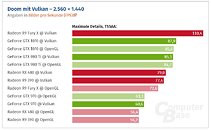- Joined
- Oct 9, 2007
- Messages
- 47,670 (7.43/day)
- Location
- Dublin, Ireland
| System Name | RBMK-1000 |
|---|---|
| Processor | AMD Ryzen 7 5700G |
| Motherboard | Gigabyte B550 AORUS Elite V2 |
| Cooling | DeepCool Gammax L240 V2 |
| Memory | 2x 16GB DDR4-3200 |
| Video Card(s) | Galax RTX 4070 Ti EX |
| Storage | Samsung 990 1TB |
| Display(s) | BenQ 1440p 60 Hz 27-inch |
| Case | Corsair Carbide 100R |
| Audio Device(s) | ASUS SupremeFX S1220A |
| Power Supply | Cooler Master MWE Gold 650W |
| Mouse | ASUS ROG Strix Impact |
| Keyboard | Gamdias Hermes E2 |
| Software | Windows 11 Pro |
Over the weekend, Bethesda shipped the much awaited update to "DOOM" which can now take advantage of the Vulkan API. A performance investigation by ComputerBase.de comparing the game's Vulkan renderer to its default OpenGL renderer reveals that Vulkan benefits AMD GPUs far more than it does to NVIDIA ones. At 2560 x 1440, an AMD Radeon R9 Fury X with Vulkan is 25 percent faster than a GeForce GTX 1070 with Vulkan. The R9 Fury X is 15 percent slower than the GTX 1070 with OpenGL renderer on both GPUs. Vulkan increases the R9 Fury X frame-rates over OpenGL by a staggering 52 percent! Similar performance trends were noted with 1080p. Find the review in the link below.

View at TechPowerUp Main Site

View at TechPowerUp Main Site





 In fact R9 Fury cards in general shine in DX12 and apparently also in Vulkan. While I love my GTX 980 I kinda regret I haven't gone with R9 Fury/Fury X.
In fact R9 Fury cards in general shine in DX12 and apparently also in Vulkan. While I love my GTX 980 I kinda regret I haven't gone with R9 Fury/Fury X.